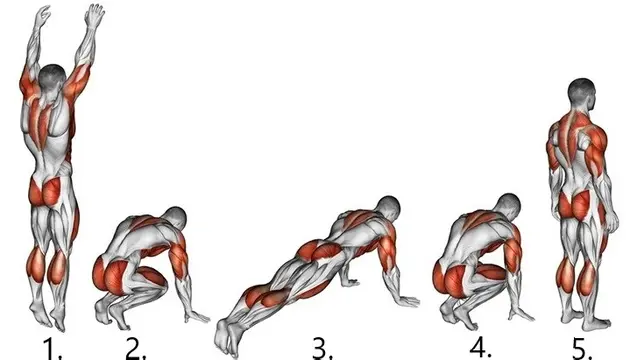Burpees are one of those exercises that most people love to hate. A challenging set of burpees can leave you feeling totally exhausted, but they can also produce remarkable improvements in fitness without the use of expensive gym equipment or complicated workouts.
The burpee works your entire body, and there are modifications for beginner, intermediate, and advanced exercisers. You can do burpees on their own for a simple, time-efficient workout or put them into high-intensity interval training (HIIT) or circuit training workouts.
In this in-depth guide, we’re going to discuss the origin of burpees, explain why and how to do them, and provide you with a whole lot of variations that you can use to keep your workouts fresh and interesting.
What Are Burpees?
Burpees are a calisthenic or bodyweight exercise named after American physiologist Royal H. Burpee (1). They were invented as a quick and straightforward way to assess the all-around fitness of WWII army recruits.
In fitness terms, a burpee is a complex as it’s actually several exercises done back-to-back to create a sequence. Those exercises are:
- Squat
- Squat thrust
- Push-up
- Squat jump
The burpee has since become a firm favorite with anyone looking to develop a high level of fitness. They’re a common exercise in CrossFit, and people in the military and special forces, MMA fighters and other athletes, and hardcore workout enthusiasts use burpees to improve their fitness and endurance, and for weight control.
Level Up Your Fitness: Join our 💪 strong community in Fitness Volt Newsletter. Get daily inspiration, expert-backed workouts, nutrition tips, the latest in strength sports, and the support you need to reach your goals. Subscribe for free!
Burpee Muscles Worked
Burpees work virtually every muscle in your body, the most notable exceptions being your biceps and latissimus dorsi muscles. As for your other muscles – they are guaranteed to get a great workout with burpees.
Burpees work the following major muscles:
Quadriceps – the muscles on the front of your thighs that are responsible for knee extension.
Hamstrings – located on the back of your thighs, the hamstrings are responsible for knee flexion and hip extension.
Gluteus maximum – known as the glutes for short, this large butt muscle is another hip extender.
Erector spinae – the collective term for the muscles of your lower back.
Core – the collective term for the muscles of your midsection.
Triceps brachii – known as the triceps for short, this muscle is located on the back of your upper arm and is responsible for extending your elbow.
Pectoralis major – located on the front of your chest, the pecs flex your shoulder horizontally.
Deltoids – there are three deltoid muscles; anterior, medial, and posterior. All three work together during burpees, but the anterior or front deltoid is the most active. The deltoids are your main shoulder muscles.
Iliopsoas – located at the top of the front of your hips, the iliopsoas is your main hip flexor. It’s actually two muscles; the iliacus and the psoas major.
Triceps surae – the collective term for your two calf muscles. The triceps surae consists of the gastrocnemius, which is the larger, uppermost muscle, and the smaller, lowermost soleus.
In addition to these muscles, a high-rep set of burpees will leave you huffing and puffing like an old steam train, so your heart and lungs will get a great workout too.
The Benefits and Advantages of Burpees
If you’ve ever done burpees, you already know how tough this exercise can be. The good news is that every rep you perform is doing you good!
The main benefits and advantages of burpees include:
Total-body conditioning – burpees work almost every major muscle in your body. As such, they’re very functional because they train your body as it works in nature. Whether you play sports or just want to work your whole body in one straightforward exercise, burpees can help.
Do them anywhere – with no equipment required, you can do burpees almost anywhere and anytime. You can do them at a commercial or garage gym, at home in your bed or living room, in a hotel room, at the park…they’re the ultimate excuse-free exercise.
Burpees can be modified to suit most fitness levels – there are many ways to make burpees easier or harder. For example, dropping the final squat jump from the sequence makes them more manageable, while variations like box-jump and muscle-up burpees are much harder.
Burn fat – a high-rep set of burpees will burn lots of calories while you are doing them and also increase your metabolism afterward. If you want to get lean or just avoid weight gain, burpees can help.
Increase leg power – power is your ability to generate force quickly. Most burpee variations involve a squat jump. Jumping exercises like burpees are an excellent way to increase muscle power.
Build your cardiovascular fitness – because burpees involve so many muscles, doing them will increase your heart and breathing rate, delivering a useful cardiovascular workout in the process. They’re a good fitness builder and a handy alternative to things like jump rope, jumping jacks, and jogging.
Time-efficient – short on time? Ten minutes of burpees will provide a decent workout that you can do almost anywhere. There is no need to work your legs, core, arms, and shoulders separately; burpees train all of these muscles at the same time!
Who Should NOT Do Burpees?
There is no denying the advantages and benefits of burpees, but this potent exercise is not suitable for everyone. Reasons to be extra cautious or even avoid burpees completely include:
- If you’re very overweight
- Suffering from knee, hip, lower back, elbow, or shoulder pain
- Pregnant
- Recent abdominal surgery
How to Do Burpees
To get the most from any exercise, you need to do it right. While performing an exercise properly doesn’t necessarily make it easier, it generally makes it safer and puts less stress on your joints.
- Stand with your feet together and your hands by your sides.
- Squat down and place your hands flat on the floor in front of your feet shoulder-width apart. Try not to round your lower back.
- Jump your feet out and back to land in the push-up position.
- Bend your arms and lower your chest to lightly touch the floor.
- Push back up to full arm extension.
- Jump your feet in and under your body, knees close to your elbows.
- Leap up into the air as high as you can.
- Land on slightly bent knees and then repeat, repeat, REPEAT!
Tips for Better Performance and Mistakes to Avoid
Burpees involve a lot of coordination, and the more tired you get, the worse your technique will become. Poor technique can lead to injuries, so keep the following points in mind to make your burpee workout as safe and effective as possible.
Level Up Your Fitness: Join our 💪 strong community in Fitness Volt Newsletter. Get daily inspiration, expert-backed workouts, nutrition tips, the latest in strength sports, and the support you need to reach your goals. Subscribe for free!
- When you drop into the first squat, try to keep your feet flat on the floor.
- Squat all the way down – don’t just bend over from your waist. Your hips should be below the level of your knees when you put your hands on the floor for the push-up.
- Descend quickly but under control. Do not just drop into a low squat, or your knees will suffer.
- Avoid diving onto your hands for the push-up as you may hurt your wrists.
- Keep your core tight; do not let your hips drop out of proper alignment.
- Keep your neck neutral as you do the push-up. Do not lower your head toward the floor.
- Don’t bounce your chest off the floor. Touch down lightly and without letting your hips drop.
- Jump your feet back in as close to your hands as possible.
- Leap into the air off of flat feet if possible to reduce the strain on your knees.
- Always land on slightly bent knees to absorb the impact that could otherwise hurt your feet, ankles, knees, hips, or back.
Burpee Variations
As undeniably awesome as burpees are, you’ll soon get bored if you only ever do the variation described above.
Thankfully, there are lots of different burpee variations that you can use to keep your workouts fresh and exciting. There are burpee versions that are easier and harder than the standard version described before, so use the variation that best matches your current fitness level.
Beginner burpees – if you are new to burpees, this is a good place to start. This exercise is sometimes called a squat thrust and is actually the version that Royal H. Burpee originally described.
Simply squat down, jump your feet to the rear, jump them back in and stand up. As you get stronger, add the push-up or jump and then work up to doing the full version.
Double push-up burpees – do two push-ups instead of one to increase the upper body work per rep.
180-degree turn burpees – do a 180-degree jump at the end of each burpee, so you land facing the opposite direction. This adds an additional coordination challenge.
Lateral jump burpees – do your burpees standing sideways onto the knee-high hurdle. When it comes time to do the jump, leap sideways over the hurdle and into your next rep.
Long jump burpees – instead of jumping as high as you can at the end of each rep, jump as far as you can. For a fun and challenging workout, do your burpees for distance instead of reps, e.g., over 100 meters, 400 meters, or, if you are crazy fit, a mile!
Tuck jump burpees – as you leap into the air, pull your knees up into your chest and grab your shins with your hands. Snap your legs down quickly and land on slightly bent knees. This drives up the leg power component of burpees and will really set your lungs on fire!
Box jump burpees – stand in front of a sturdy and stable box or exercise bench. Perform your burpee as usual but then jump forward and up onto the box. This variation keeps you honest as each jump will be the same height.
Clean and press burpees – using a medicine ball, barbell, or dumbbells, hold the weight(s) in your hands, squat down, jump your feet back, perform a single push up, jump your feet in, stand up and clean the weight to shoulder height and then push it overhead. This variation is not for the uncoordinated or faint-hearted.
Pull-up burpees – do your burpees beneath a pull-up bar and perform a single pull-up after each jump. This addition means you really are training every muscle in your body as pull-ups work your otherwise neglected biceps and lats.
Muscle-up burpee – for this variation, you finish your burpee with a pull-up but then push yourself up and above the bar in a sort of dip motion called a muscle-up. This is for advanced exercisers only and will challenge every aspect of your fitness and strength.
The man-maker – man makers are burpees on steroids! You’ll need a pair of dumbbells for this variation.
- Holding a dumbbell in each hand, stand with your feet together and your arms by your sides.
- Squat down and place the dumbbells on the floor.
- Jump your feet back and into the push-up position.
- Bend your arms and do a push-up.
- Next, row one dumbbell up into your ribs. Place it back on the floor and then repeat on the opposite side.
- After the rows, jump your feet up and into your hands. Drop your hips and arch your lower back.
- Stand up and clean the weights up to your shoulders, and then squat-press the weights up and overhead.
- Lower the weights back to your shoulders and then down to the floor.
- That’s one rep; keep going!
Burpees are effective and versatile. They deliver results, and most variations require no special workout equipment. Assuming it is safe for you to do them, burpees are a great addition to any workout, whatever your fitness goals are.
Burpee Workouts
While you can add burpees to your next circuit or HIIT workout, they’re a tremendous stand-alone exercise too. There is something really refreshing and rewarding about doing nothing but burpees; just switch off your brain and start cranking out the reps. Who said fitness training had to be complicated?!
Remember to warm-up before doing any of these workouts. A few minutes of light cardio, e.g., jumping rope, followed by some dynamic flexibility and mobility exercises should suffice. End your warm-up with a few reps of half-speed burpees to make sure you’re one hundred percent ready for the workout you are about to do.
1. Race to 100 reps
For this workout, just do 100 burpees as fast as you can. Do as many reps as possible, rest a moment, and then do some more. Keep on pumping out the reps until you hit your century. Try to beat your time when you next do this workout. The shorter your rests, the better your time will be.
2. 10-minute burpee challenge
Similar to workout #1, just see how many reps you can complete in ten minutes. Rest when you need to but keep on going until the time runs out. In many cases, lots of short sets and brief rests work better than longer sets with extended rests.
3. Favorite song finisher
Most people have a favorite training song that never fails to get them pumped up. Use this song to motivate you to reach burpee nirvana! See how many reps you can do while your favorite music plays. Needless to say, a very short thrash metal song is better than a very long extended remix. Three to five minutes is the ideal length of song for this workout.
4. Breathing ladder burpees
For this workout, do one burpee and then take one deep breath. Then do two burpees and take two deep breaths. Keep adding a burpee and a breath until you can no longer match your breathing to your burpees.
5. 20-1 burpee challenges
Also known as the prisoner burpee challenge, this workout will kick your butt in nothing more than a couple of meters of space. It’s popular in jails, hence the name.
- Do 20 burpees, rest a moment.
- Do 19 burpees, rest again.
- Do 18 burpees, rest, etc.
- Do 1 burpee, collapse!
Rest as long as you want between sets but, remember, the clock is always ticking, so try to move onto the next set as soon as possible.
6. Burpee push-up ladder
This short but sweet workout puts an emphasis on the push-up part of your burpee.
- Do one burpee with one push-up.
- Do one burpee with two push-ups.
- Do one burpee with three push-ups, etc.
- Do one burpee with ten push-ups to finish.
7. Partner burpee battle
Unleash your competitive spirit by challenging your training partner to a workout game of burpee battle.
Stand facing your partner and do one burpee. They then do the same. You do two burpees, and they do likewise. Keep adding a rep until one of you is unable or unwilling to continue. The only rest you get is while your partner is doing their reps. The winner is then crowned today’s Burpee King.
8. Tabata burpees
Four minutes of burpees might sound easy, but Tabata training is renowned for making very short workouts feel like never-ending nightmares. This could be the toughest four minutes of your life!
Just do eight sets of maximum speed burpees, resting 10 seconds between each set. Just keep reminding yourself, “it’s only four minutes, it’s only four minutes…”
9. EMOM burpees
For EMOM workout, do ten burpees at the start of each minute for ten minutes. Whatever time you have left after your ten reps is your rest period. If you can’t do ten burpees, feel free to do seven or even five reps every minute instead. Increase your rep count as you get fitter.
Burpees – Wrapping up
Burpees are a very low-tech exercise, but that does not mean they aren’t effective. In fact, very few exercises can come close to the total conditioning effect of this (un)popular movement! Not many people enjoy doing burpees, but even the haters love the effect and benefit of doing this calisthenic classic. Burpees will strengthen your body AND your mind.
Whether you add them to your next circuit training session or HIIT workout, or do one of our tried-and-tested burpee-only workouts, the humble burpee will help you burn fat and get fit, even if you’ve only got a jail cell to train in.
References:
Columbia University: Seven Quickly Administered Tests of Physical Capacity and Their Use in Detecting Physical Incapacity for Motor Activity in Men and Boys (source)
Interested in measuring your progress? Check out our strength standards for Push Ups, Pull Ups, Clean and Press, and more.










